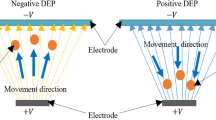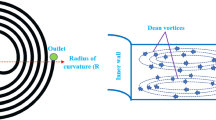Abstract
In the recent years, microfluidic lab-on-chip devices have become very popular in point-of-care medical diagnosis and liquid biopsy analyses. However, the developed devices are only for isolation of cells or extraction of plasma. In order to provide reliable solution for complete medical analysis and liquid biopsy, by means of separating distinct blood cells and plasma, we have developed a microfluidic lab-on-chip device utilizing negative dielectrophoresis (DEP) mechanism. In this work, the design of the lab-on-chip has been analyzed using COMSOL Multiphysics 5.4 simulation tool. To achieve efficient separation performance, triangular micro-tip electrodes have been used which are capable of generating higher electric field strength resulting in higher negative dielectrophoretic force than the normal electrodes. The chip has been tested with two types of whole blood (type 1 containing platelets, red blood cells and white blood cells and type 2 containing platelets, red blood cells and myeloid leukemia cells) which has been diluted inside the chip, thereby eliminating any necessity of external sample preparation. The device has achieved efficient and higher separation performance in terms of cell separation purity, cell separation efficiency and plasma separation purity. Also, curved microchannel-based geometry of the chip has been able to provide higher plasma recovery than the normal flat microchannel. This can be the solution in case of lower throughput DEP platforms.

















Similar content being viewed by others
References
Döhner H, Weisdorf DJ, Bloomfield CD (2015) Acute myeloid leukemia. N Engl J Med 373(12):1136–1152
Sollier E, Cubizolles M, Fouillet Y, Achard JL (2010) Fast and continuous plasma extraction from whole human blood based on expanding cell-free layer devices. Biomed Microdevice 12(3):485–497
Harwood R (1974) Cell separation by gradient centrifugation. Int Rev Cytol 38:369–403
Chin CD, Linder V, Sia SK (2007) Lab-on-a-chip devices for global health: Past studies and future opportunities. Lab Chip 7(1):41–57
Gossett DR, Weaver WM, Mach AJ, Hur SC, Tse HTK, Lee W (2010) Label-free cell separation and sorting in microfluidic systems. Anal Bioanal Chem 397(8):3249–3267
Catarino SO, Rodrigues RO, Pinho D, Miranda JM, Minas G, Lima R (2019) Blood cells separation and sorting techniques of passive microfluidic devices: from fabrication to applications. Micromachines 10(9):593
Jackson EL, Hang Lu (2013) Advances in microfluidic cell separation and manipulation. Curr Opin Chem Eng 2(4):398–404
Petersson F, Åberg L, Swärd-Nilsson AM, Laurell T (2007) Free flow acoustophoresis: microfluidic-based mode of particle and cell separation. Anal Chem 79(14):5117–5123
Karthick S, Sen AK (2018) Improved understanding of acoustophoresis and development of an acoustofluidic device for blood plasma separation. Phys Rev Appl 10(3):034037
Fattah ARA, Ghosh S, Puri IK (2016) High gradient magnetic field microstructures for magnetophoretic cell separation. J Chromatogr B 1027:194–199
Yang F, Zhang Y, Cui Xi, Fan Y, Xue Y, Miao H, Li G (2019) Extraction of cell-free whole blood plasma using a dielectrophoresis-based microfluidic device. Biotechnol J 14(3):1800181
Yan S, Zhang J, Alici G, Haiping Du, Zhu Y, Li W (2014) Isolating plasma from blood using a dielectrophoresis-active hydrophoretic device. Lab Chip 14(16):2993–3003
Wang X, Chen S, Kong M, Wang Z, Costa KD, Li RA, Sun D (2011) Enhanced cell sorting and manipulation with combined optical tweezer and microfluidic chip technologies. Lab Chip 11(21):3656–3662
Lee MG, Choi S, Kim H-J, Lim HK, Kim J-H, Huh N, Park J-K (2011) Inertial blood plasma separation in a contraction–expansion array microchannel. Appl Phy Lett 98(25):253702
Spigarelli L, Bertana V, Marchisio D, Scaltrito L, Ferrero S, Cocuzza M, Marasso SL, Canavese G, Pirri CF (2019) A passive two-way microfluidic device for low volume blood-plasma separation. Microelectron Eng 209:28–34
Guan Y, Liu Y, Lei H, Liu S, Xu F, Meng X, Yang G (2020) Dielectrophoresis separation of platelets using a novel zigzag microchannel. Micromachines 11(10):890
Zhang Y, Chen X (2020) Dielectrophoretic microfluidic device for separation of red blood cells and platelets: a model-based study. J Braz Soc Mech Sci Eng 42(2):1–11
Shirinkami H, Wang G, Park J, Ahn J, Choi Y, Chun H (2020) Red blood cell and white blood cell separation using a lateral-dimension scalable microchip based on hydraulic jump and sedimentation. Sens Actuators B Chem 307:127412
Pethig, Ronald R (2017) Dielectrophoresis: theory, methodology and biological applications.” John Wiley & Sons
Turcu I, Lucaciu CM (1989) Dielectrophoresis: a spherical shell model. J Phys A Math Gen 22(8):985–993
Zhang Y, Chen X (2020) Blood cells separation microfluidic chip based on dielectrophoretic force. J Braz Soc Mech Sci Eng 42(4):1–11
Maria MS, Chandra TS (2017) Capillary flow-driven blood plasma separation and on-chip analyte detection in microfluidic devices. Microfluid Nanofluid 21(4):72
Ali H, Park CW (2016) Numerical study on the complete blood cell sorting using particle tracing and dielectrophoresis in a microfluidic device. Korea Aust Rheol J 28(4):327–339
Mohamed Zackria Ansar BI, Tirth V, Yousuff CM, Shukla NK, Islam S, Irshad K, Mohammed Aarif KO (2020) Simulation guided microfluidic design for multitarget separation using dielectrophoretic principle. BioChip J 14(4):390–404
Oshiro K, Wakizaka Y, Takano M, Itoi T, Ohge H, Koba K, Yarimizu K, Fujiyoshi So, Maruyama F (2022) Fabrication of a new all-in-one microfluidic dielectrophoresis integrated chip and living cell separation. Iscience 25(2):103776
Piacentini N, Mernier G, Tornay R, Renaud P (2011) Separation of platelets from other blood cells in continuous-flow by dielectrophoresis field-flow-fractionation. Biomicrofluidics 5(3):034122
Hou HW, Warkiani ME, Khoo BL, Li ZR, Soo RA, Tan DSW, Lim WT, Han J, Bhagat AAS, Lim CT (2013) Isolation and retrieval of circulating tumor cells using centrifugal forces. Sci Rep 3(1):1–8
Acknowledgements
For this research work, we would like to recognize MEMS Lab, National Institute of Technology Nagaland, Chumukedima-797103 for providing the software and their extended support. Here, in this work, the simulations are carried out with the system consisting following specifications; DELLG15, 11th Gen Intel(R) Core(TM) i7-11800H @ 2.30GHz processor with 16 GB RAM. The simulation runtime varies from 20 to 30 minutes.
Author information
Authors and Affiliations
Corresponding author
Additional information
Technical Editor: Daniel Onofre de Almeida Cruz.
Publisher's Note
Springer Nature remains neutral with regard to jurisdictional claims in published maps and institutional affiliations.
Rights and permissions
Springer Nature or its licensor holds exclusive rights to this article under a publishing agreement with the author(s) or other rightsholder(s); author self-archiving of the accepted manuscript version of this article is solely governed by the terms of such publishing agreement and applicable law.
About this article
Cite this article
Pakhira, W., Kumar, R., Ibrahimi, K.M. et al. Design and analysis of a microfluidic lab-on-chip utilizing dielectrophoresis mechanism for medical diagnosis and liquid biopsy. J Braz. Soc. Mech. Sci. Eng. 44, 482 (2022). https://doi.org/10.1007/s40430-022-03793-4
Received:
Accepted:
Published:
DOI: https://doi.org/10.1007/s40430-022-03793-4




